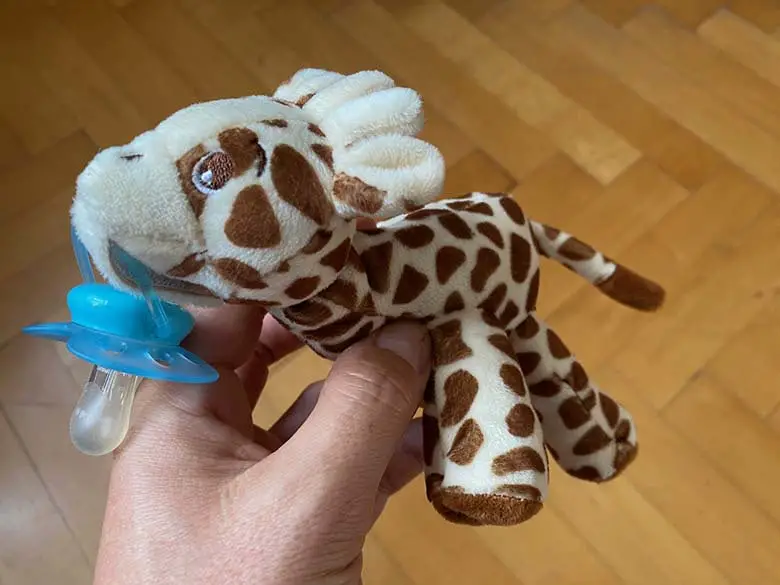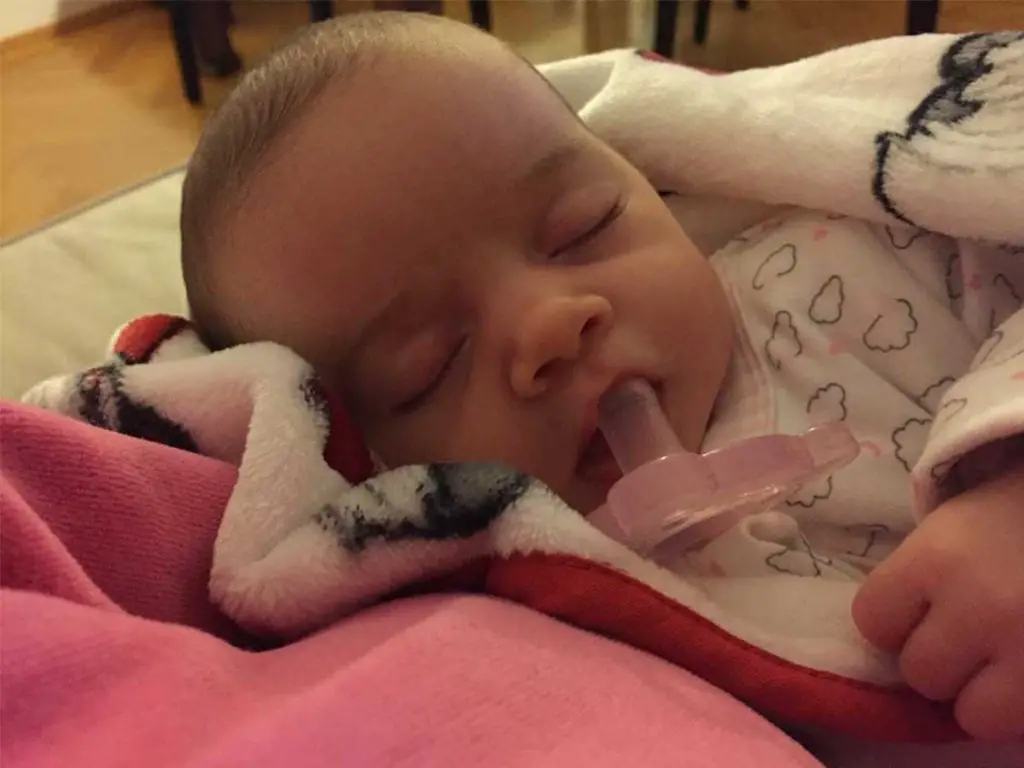My daughter was never a difficult baby, but when it came to her pacifier, there were some issues. She would push it out of her mouth with her tongue. It was a frustrating experience, and it made me do a lot of research, go through trial and error on what to do when a baby won’t take a pacifier.
A lot of babies either won’t take a pacifier at all or suddenly just stop taking them. Often there is a simple explanation, e.g. the pacifier is of the wrong shape or size or you try to give it to them when they’re upset. Sometimes the solution can be simple: changing the pacifier or giving it to them when they’re calmer.
- When to introduce a pacifier to a baby
- Why do some babies not take pacifiers?
- Tips on how to get your baby to take pacifiers (with pacifier recommendations)
- Exercise patience
- Make it tasty
- Bait and switch technique to get a breastfed baby to take a pacifier
- Try other pacifiers with different sizes, shapes, and material
- Tips get baby to enjoy a pacifier that takes bottles but not a pacifier
- Soothe your baby if you decide not to keep trying to get your baby to take a pacifier
- Risks and benefits of pacifiers
- Is it bad if my baby won't take a pacifier?
When to introduce a pacifier to a baby
According to the American Academy of Pediatrics (AAP), the best time to introduce your baby to a pacifier is at one month and older. Introducing the pacifier at bedtime will reduce the risk of SIDS. Don’t introduce a pacifier until you’ve established a feeding and nursing routine. Your little one should also be grasping how to breastfeed without a fuss.
Why do some babies not take pacifiers?
Some babies refuse to take pacifiers from the onset (like my daughter) or they might suddenly refuse to take them after some weeks of usage. There are also a few other scenarios that might lead to your little one rejecting the pacifier.
Not offering the pacifiers at appropriate times
Offering your baby their pacifier at the wrong times is a common mistake parents make. A pacifier should never be given to your little one when they’re hungry. A pacifier won’t ease her hunger and will cause you to miss hunger cues.
Baby prefers the breast
In our case, our little lady simply preferred the breast. It’s not unusual for babies to have this preference or even to use breasts as pacifiers.
Baby prefers bottles
Some little ones prefer bottles. They associate their bottles with calmness and enjoy the process.
Wrong pacifier size, shape, and material is offered
Babies are less likely to show interest in a pacifier if the size and shape are incorrect. A pacifier that’s too big, or oddly shaped will be uncomfortable and the little one will reject it. Parents often invest in the most expensive pacifier believing that will be best, but these types can be too big or made from an uncomfortable material.
Tips on how to get your baby to take pacifiers (with pacifier recommendations)
It can be challenging to get your little one to take a pacifier, especially if they appear determined not to. Here’s a video with some helpful tips:
To summarize, I’ve broken the tips down into easy-to-follow steps:
- Wait for the perfect moment when your little one is calm
- Hold your baby comfortably in your arm and gently put some pressure around their mouth using the pacifier
- Optional encouraging method: dip the pacifier into milk, formula, or even gripe water
- If you place the pacifier on the tip of their tongue, they might gag. Rather, gently move the pacifier to the middle of the tongue.
- Move it around in their mouth in slow and gentle but firm circles.
- Talk to them, swaddle, and smile, so that they can see it’s nothing bad.
- If they gag, move the pacifier off the tongue and around her mouth.
- Be calm and relaxed, so that your baby won’t feel your stress and associate the pacifier with a negative impulse.
The handy WubbaNub Brown Monkey is the one featured in the video clip!
Exercise patience
One of the biggest tips I can give you is – “EXERCISE PATIENCE”. Wait for a moment when your little one is calm and not fussing. Hold the baby for a few minutes before and talk so that they calm down completely. Remember, it might not happen on the first day. You might experience several different attempts before being successful.
Make it tasty
Dipping the pacifier in milk, formula, or gripe water will add a bit of sweetness and might make it more appealing to your baby. Since honey can lead to infant botulism, you shouldn’t dip the pacifier in honey. Sugar is also not recommended as the baby’s digestive tract might not be able to handle the extra sugar.

Bait and switch technique to get a breastfed baby to take a pacifier
One of the easiest ways to get your breastfed baby to take the pacifier is something called the bait and switch technique. I saw this technique mentioned on a Reddit forum. Start the little one on the breast or by holding your finger to the lips. While the baby is completely distracted, slip a pacifier into their mouth and with a bit of luck, they’ll keep sucking!
A product that could be helpful in this instance is the Evenflo Feeding Balance. This type of pacifier is designed to promote a baby’s natural tongue position. It’s a great pacifier to get your baby to self-soothe and develop healthy sucking skills. It’s ultra-lightweight, made from 100% silicone and its flexibility decreases mouth fatigue.
Try other pacifiers with different sizes, shapes, and material
One of the other ways to get your baby interested in pacifiers is to change the options you use. Get a pacifier with a different shape, size, or even material. It might make the difference.
Aside from the WubbaNub Brown Monkey Pacifier, we had success with the WubbaNub giraffe version.

Pacifier materials
The material is typically rubber and silicone. In general, rubber isn’t only cheaper but also more flexible. They’re also more durable because cleaning them is as easy as sterilizing them with boiling water.
Shape
The two main pacifier shapes are bell and orthodontic. Orthodontic shapes are designed to resemble a woman’s nipple. These are also the types that are suggested for babies who breastfeed. When it comes to size, you have to ensure you get the right size for your little one’s age. The wrong size could make your little one feel as though they’re choking and they’ll reject it.
Another favorite of mine is the Soothie pacifier, which I covered in this comparison article on soothie versus super soothie vs pacifier. It’s made of medical-grade silicone and they’re the ones used in the neonatal wards in hospitals.
Tips get baby to enjoy a pacifier that takes bottles but not a pacifier
Some babies prefer a bottle to a pacifier. There are however a few tips you can try to convince them to swap the bottle for a pacifier.
- Try when the baby is sleepy: After the baby has been fed, try and switch the bottle for a pacifier immediately. But do it quickly and if you’re lucky, the little one won’t notice.
- Try a different pacifier: Try a pacifier with a different shape. Possibly one that resembles the bottle nipple.
- Heat the dummy: Try warming the pacifier in some warm water to make it more appealing.
- Stroke the baby’s nose: Some babies can easily be distracted by rubbing their noses. You might use this technique to distract them while you switch the bottle for the pacifier.
Another option to try is Dr.Brown’s HappyPaci. This nifty silicone pacifier is shaped like Dr. Brown’s Happy bottle nipple. It might fool your baby into believing it’s the bottle!
Soothe your baby if you decide not to keep trying to get your baby to take a pacifier
Try as you may, you might not always win the pacifier battle. Here are some tips to try if you’re going to give up on the frustration of getting your baby to take a pacifier.
- Create a bedtime routine: Routines can provide the baby’s body with signals that it’s time to relax and go to sleep. Bathing or swaddling help here.
- Substitute the pacifier: Use a security object like a soft toy or blanket they’re attached to. Ensure this object is always around. You might want to get a few of them!
- Increase the swaddling: You might have to swaddle a little more before bedtime as this often helps for babies who don’t want pacifiers.
Risks and benefits of pacifiers
Benefits (pros)
Pacifiers are the perfect way to keep babies content between feedings. Read on to see some of the benefits:
- Offers temporary distraction: Pacifiers are ideal ways to keep a baby occupied during blood tests or shots.
- Helps baby to fall asleep: If your baby is very restless just before bedtime, a pacifier might help them settle down.
- Soothes fussing: Some babies can get fussy for no apparent reason, and will only settle down when they’re sucking on something.
- Ease discomfort during flying: Air pressure changes can cause ear pain. Sucking on a pacifier could relieve some of this pain.
- Can reduce risk of SIDS: Sucking on a pacifier at bed and nap time could reduce the chance of sudden infant death syndrome.
- Disposable: Pacifiers can easily be disposed of when they’re damaged or no longer needed.
Risks (cons)
Pacifiers can have a few risks that you should be aware of. Some of the most crucial risks are listed below:
- Babies become attached: Some babies become attached to their pacifiers and it presents a struggle to get them weaned off them.
- Increased risk of ear infections: This is only a risk when the baby is 6 months and older.
- Difficult to sleep: While pacifiers are great ways to get babies to sleep, at some point they need to be weaned off them. They might find it difficult to fall asleep without it.
- Bad habit for parents: Parents can become spoiled if the pacifier eases a fussing baby. Parents might rely on the pacifier at the first sign of fussing. They can overlook the real reason for the fuss.
Is it bad if my baby won’t take a pacifier?
Despite trying every possible hint and guideline, my precious little angel never quite learned what to do with a pacifier, even though before she was born we first assessed how many pacifiers and clips she would need.
I must admit, there weren’t any negative results because of it. It simply meant we had to make sure she always had one of her stuffed animals with her at nap and bedtime. She also required a little more swaddling than usual, which nobody minded either!
What it comes down to, is that it’s your personal choice if you want to try till your little one takes a pacifier, or if you can live without it. If it doesn’t work out, don’t worry about it too much, pacifiers aren’t long-term anyway! And there are some great alternatives to pacifiers!
Last update on 2024-07-23 / Affiliate links / Images from Amazon Product Advertising API

